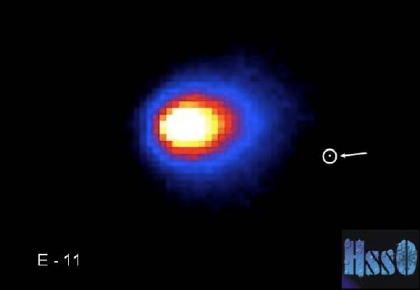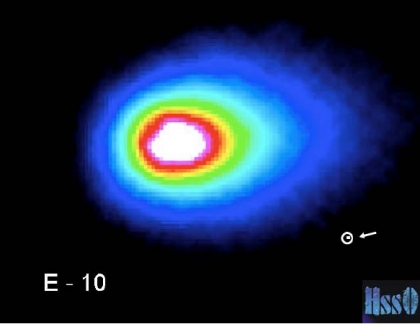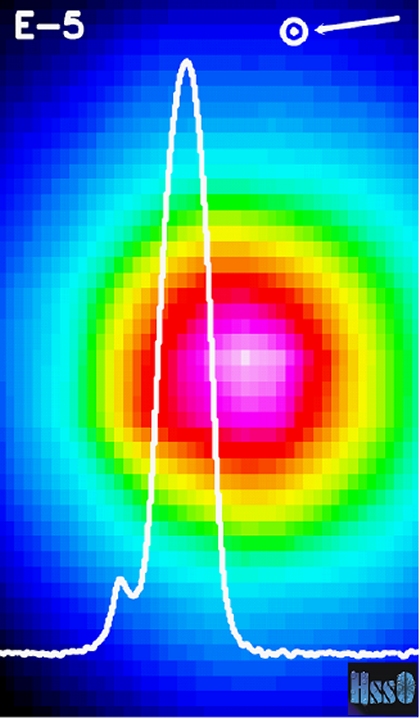Press Release 15/2010 - November 9, 2010
Comet Hartley 2 in a new light
Scientists from the Max Planck Institute for Solar System Research study the EPOXI encounter comet with the eyes of Herschel. The observations are part of a Herschel Key program.
From October 24th to November 17th, 2010 ESA's Herschel Space Observatory is using its complement of state-of-the-art instruments to observe the far-infrared and submillimetre spectrum and to image the thermal dust radiation of comet 103P/Hartley 2, covering the 55-671 micrometer spectral range. Herschel is taking part in an extraordinary worldwide astronomical campaign to study comet Hartley 2 before, during, and after the flyby by the NASA EPOXI (Extrasolar Planet Observation and Deep Impact Extended Investigation) mission on November 4th, 2010. The observations are part of the Herschel program "Water and related chemistry in the Solar System", led by the Max Planck Institute for Solar System Research in Germany.
This year's return of comet Hartley 2 is exceptional. The comet has made its perihelion passage on October 28th, 2010, having passed at a distance of 18 million kilometres from the Earth on October 20th. This has been the comet's closest approach to the Earth since its discovery in 1986 and by far its closest approach in the next century. Comet Hartley 2 passed just 16.4 million kilometers from Herschel on October 20th, providing an opportunity to acquire sensitive measurements, complementary to the observations from EPOXI and other facilities.

|
Figure 1: Comet Hartley 2 as seen by Herschel/SPIRE. This processed image was taken with SPIRE on October 24th at a wavelength of 250 micrometer, eleven days before the EPOXI's Encounter phase, with a distance between Herschel and comet Hartley 2 of 17.2 million km. The Sun symbol and arrow indicate the projected direction towards the Sun.
|
(Credits: ESA/Herschel/HssO Consortium)
|

|
Figure 2: Comet Hartley 2 as seen by Herschel/PACS. This processed image was taken with PACS on October 25th, 2010, in its "blue" channel (70 micrometer), ten days before the EPOXI's Encounter phase, with a distance between Herschel and comet Hartley 2 of 17.5 million km. The Sun symbol and arrow indicate the projected direction towards the Sun.
|
(Credits: ESA/Herschel/HssO Consortium)
|
The early Herschel observations of comet Hartley 2 already demonstrate the observatory's unique capabilities: sensitive far-infrared continuum images constrain the size of the large dust particles and spectra reveal the distribution of water molecules released from the nucleus as the ices evaporate when the comet approaches the Sun, about 230 kilograms every second. The water excitation is constrained using observations of high-excitation rotational water transitions using the three Herschel instruments: the Heterodyne Instrument for the Far Infrared (HIFI), the Spectral and Photometric Imaging REceiver (SPIRE), and the Photodetector Array Camera and Spectrometer (PACS). PACS and SPIRE allow quasi-simultaneous measurements of strong water lines. HIFI spectrally resolves the narrow line profiles, which yield key information on the kinematics of the comet's outgassing. PACS also provides images of the dust and water emission at the time of the EPOXI flyby.
"Observations of the dust coma with PACS and SPIRE allow us to constrain properties of the large dust particles and to measure the dust production rate", says Dr. Dominique Bockelée-Morvan, team member and scientist from LESIA in France. "The SPIRE observations represent the first imaging of a comet at these wavelengths of the electromagnetic spectrum", says Prof. Dr. Bruce Swinyard, team member and scientist from the University College London in the United Kingdom. "This close approach of comet Hartley 2 allows observations of weak spectral lines, not previously observed in short-period comets and high spatial resolution imaging of the water emission in the coma", says Dr. Dariusz Lis, team member from the California Institute of Technology in the USA. "We are looking forward to seeing these scientifically exciting data arrive", adds Dr. Miriam Rengel, from the Max Planck Institute for Solar System Research in Germany, team member and HIFI calibration scientist.

|
Figure 3: An image of the 538 micrometer water emission in comet Hartley 2, obtained by Herschel/HIFI, with superposed high-resolution spectrum toward the peak. The data were taken on October 30th, 2010, five days before the EPOXI encounter, with a distance between Herschel and comet Hartley 2 of 19.5 million km. The derived water production rate is 230 kg per second. The Sun symbol and arrow indicate the projected direction towards the Sun.
|
(Credits: ESA/Herschel/HssO Consortium)
|
The fast movement of comet Hartley 2, the constraints caused by the direct sunlight heating of the telescope's star trackers, and the need to schedule observations with multiple instruments during the same operational day required detailed planning for this campaign by the Herschel Mission Planning Team. Thanks to all these efforts, Herschel is observing comet Hartley 2 in fantastic detail in support of the EPOXI flyby event.
The observations reported here are part of the Herschel Guaranteed Time Key program "Water and related chemistry in the Solar System", which includes an international team of scientists led by Principal Investigator Dr. Paul Hartogh from the Max Planck Institute for Solar System Research in Germany.
Institutions involved in the comet Hartley 2 observations
Max-Planck-Institut für Sonnensystemforschung, Katlenburg-Lindau, Germany
California Institute of Technology, Pasadena, USA
Astronomy Department, University of Michigan, USA
Instituut voor Sterrenkunde, Katholieke Universiteit Leuven, Belgium
Institut d'Astrophysique et de Geophysique, Universite de Liege, Belgium
Space Science and Technology Department, Rutherford Appleton Laboratory, UK
LESIA, Observatoire de Paris, France
Herschel Science Centre, European Space Astronomy Centre, European Space Agency, Madrid, Spain
Space Research Centre, Polish Academy of Sciences, Warsaw, Poland
Rosetta Science Operations Centre, European Space Astronomy Centre, European Space Agency, Madrid, Spain
Max-Planck-Institut für extraterrestrische Physik, Garching, Germany
Additional Information
 Website of Herschel's program "Water and related chemistry in the Solar System"
Website of Herschel's program "Water and related chemistry in the Solar System"
 ESA Herschel Science Centre website
ESA Herschel Science Centre website
Contact
Dr. Paul Hartogh
Max Planck Institute for Solar System Research
Max-Planck-Straße 2
37191 Katlenburg-Lindau
Tel: 05556 979 342
Email: hartogh mps.mpg.de
mps.mpg.de
Dr. Miriam Rengel
Max Planck Institute for Solar System Research
Max-Planck-Straße 2
37191 Katlenburg-Lindau
Tel: 05556 979 244
Email: rengel mps.mpg.de
mps.mpg.de
Dr. Miguel de Val-Borro
Max Planck Institute for Solar System Research
Max-Planck-Straße 2
37191 Katlenburg-Lindau
Tel: 05556 979 323
Email: deval mps.mpg.de
mps.mpg.de
